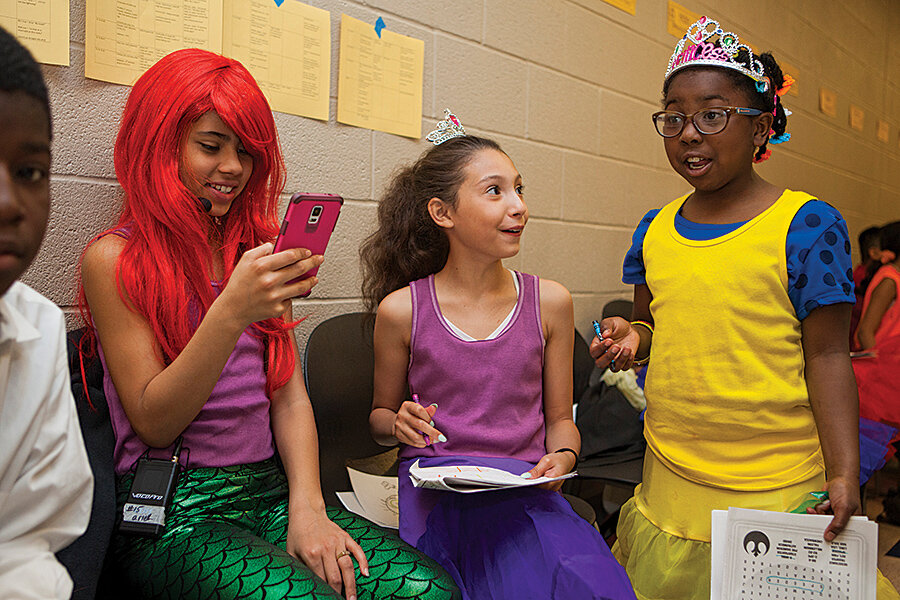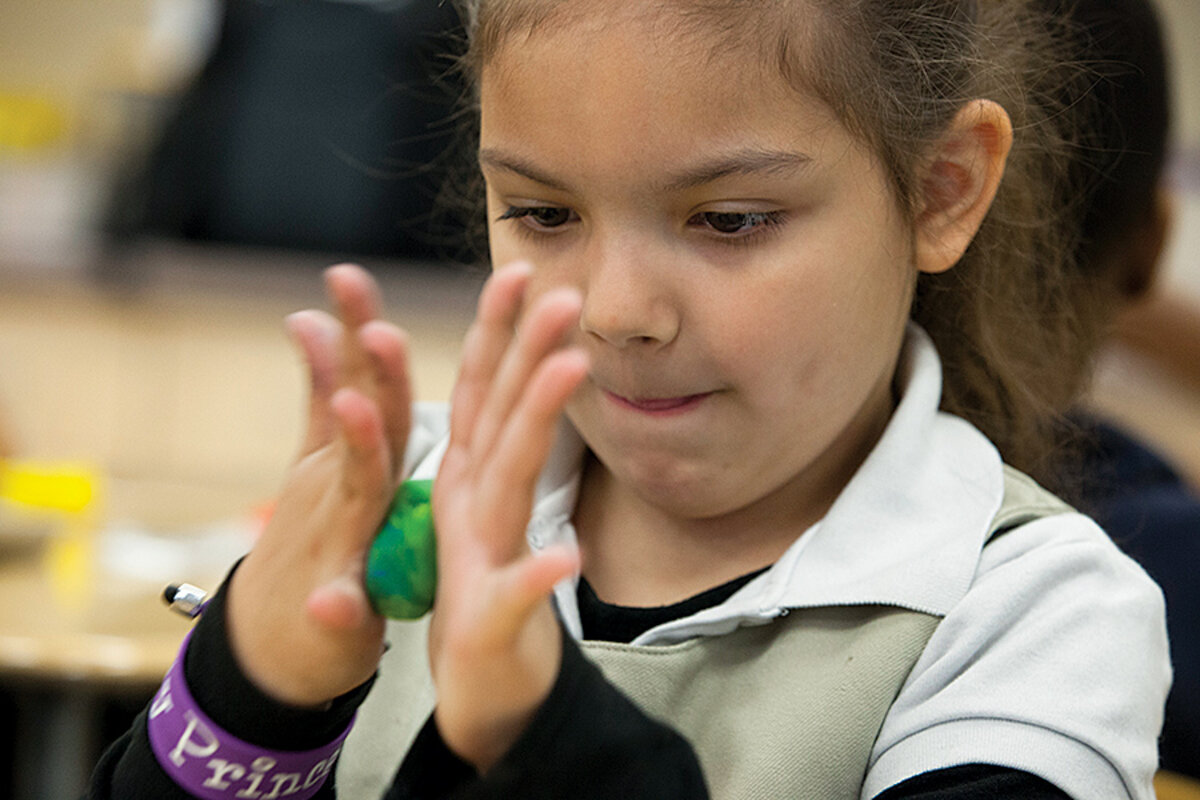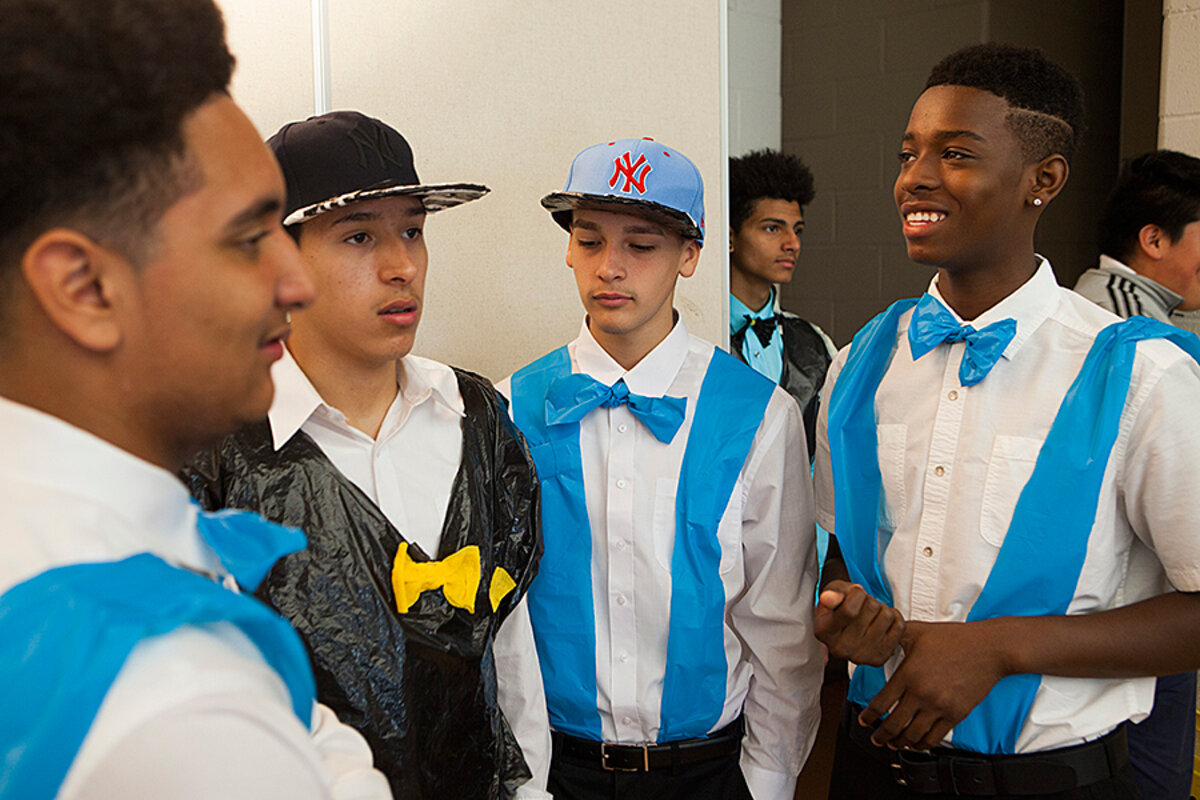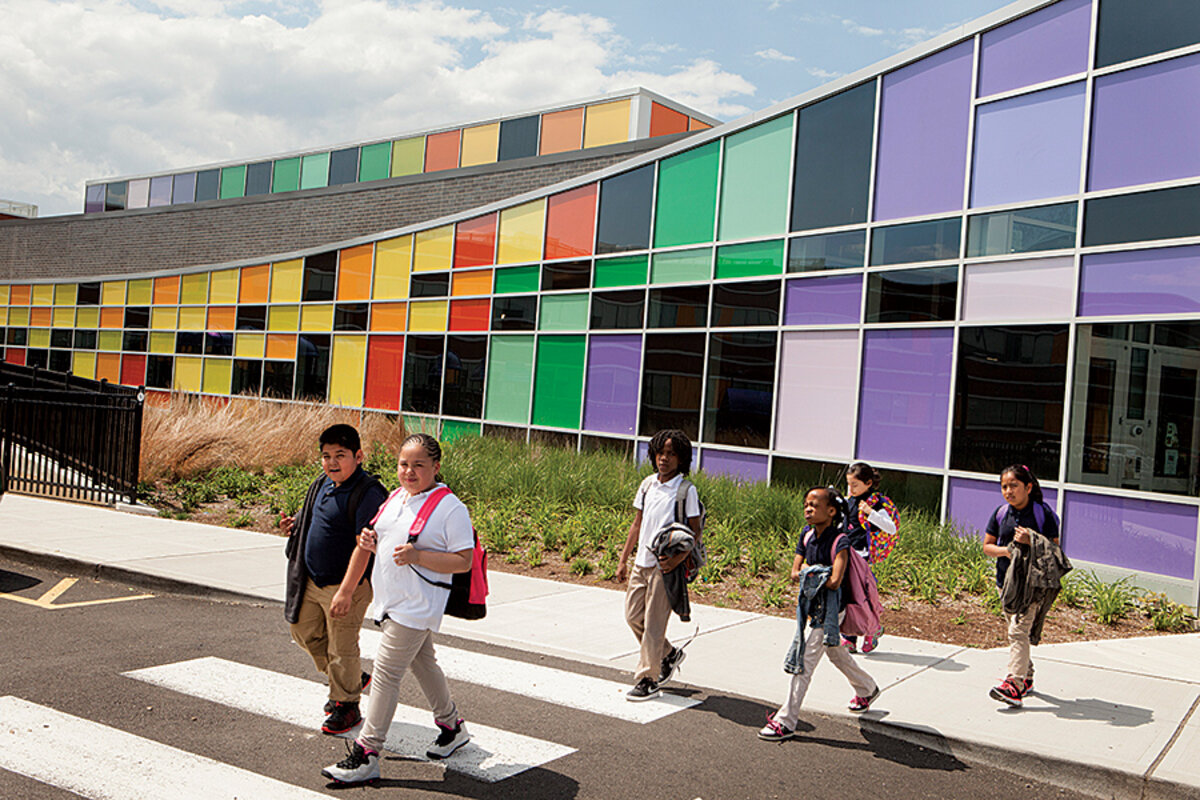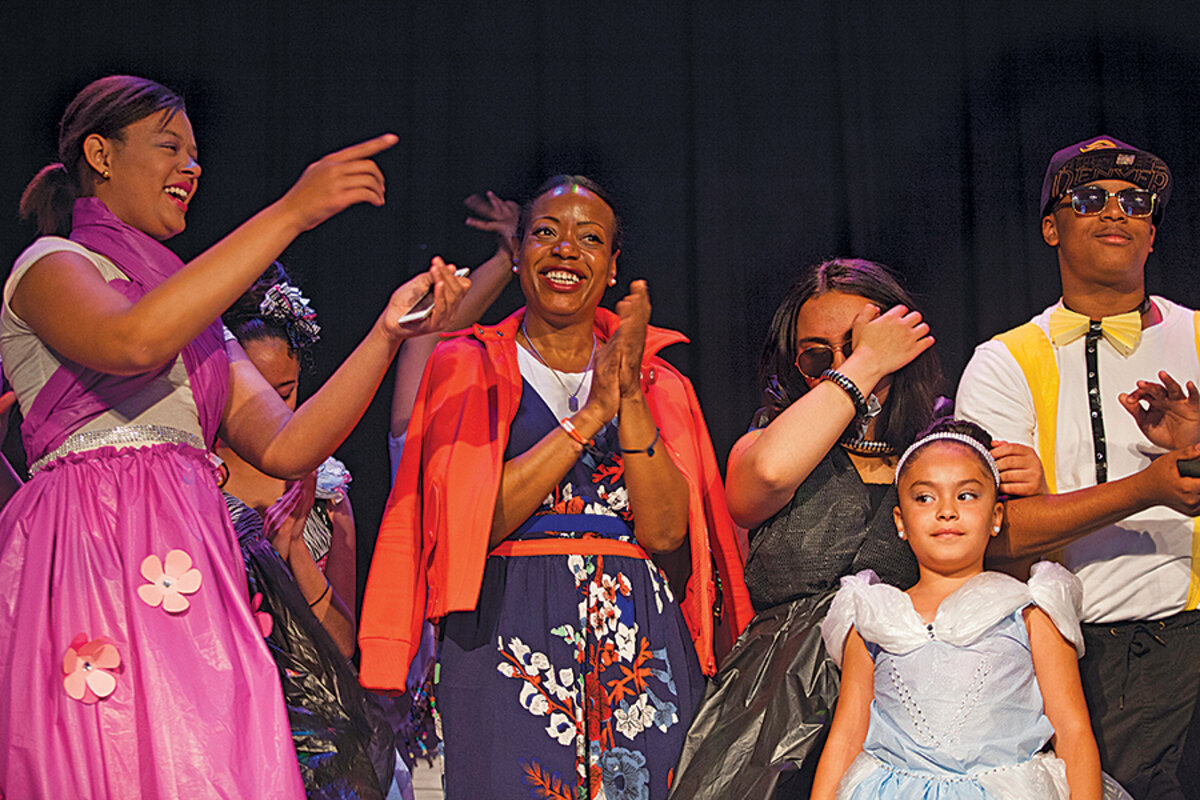The school that art saved
Loading...
| Bridgeport, Conn.
Second-grader Yadeliz Santiago is joyously mashing black magic marker into a mound of white putty. She’s shaping the gray mass to depict a stage in the life cycle of a ladybug.
Her class at the pre-K-8 Roosevelt School here has already watched a real ladybug start as an egg, go through the larvae and pupae stages, and emerge as an adult insect in a small transparent container. The students have created pictures on their iPads. And today their teacher, Lucille McFarland-Overby, is stealthily watching to see what they’ve learned.
There’s no test in sight. Just a classroom abuzz with children giving each other tips and admiring the models they’re creating. As she circulates, Ms. McFarland-Overby gleans how much new vocabulary they are using and how accurately they describe the life cycle. Some hypothesize about the insects’ behavior – one boy notes they lay eggs under leaves to protect them from other animals.
With such creative outlets, the teacher says, even children at the lowest level academically can feel successful. And then they’re more motivated when it comes to writing and answering questions – skills many of the students still need to develop.
“It brings them a lot of self-confidence, because you’re not really judging what they are doing...,” she says. “When they begin creating, they have to problem-solve, they have to take what they know and infer.”
In recent years, Roosevelt itself has transformed like a larva into a ladybug. Aided by an infusion of the arts, this school in a tough neighborhood of working-class Bridgeport has gone from being one of the lowest performing in Connecticut to a significantly improved institution: Disciplinary infractions are down, academic performance is up, and both parent and teacher pride in the school are increasing.
While paintbrushes and theatrical plays alone didn’t make Roosevelt a better school – and serious problems remain – the arts lie at the core of a quiet movement that is sweeping across the United States, helping to revive faltering schools. Eager to scale back the emphasis on standardized math and reading tests, some states and districts are searching for ways to forge a better balance among science, social studies, and the arts. It’s part of a broader definition of learning and accountability that nurtures the whole child.
Getting students ready for college and careers is still the overarching goal, of course. But increasingly, creativity and critical thinking are seen as essential – and arts education is considered an effective way to foster those characteristics.
Most public schools do offer art and music, and 42 states require some arts instruction. But arts education isn’t equitably distributed. As with many other educational opportunities, the kids with the least access to band, dance, and film class tend to be those in schools where poverty is concentrated.
In elementary schools where at least three-quarters of the students were from low-income households, 11 percent offered no music and 20 percent offered no visual arts in 2009-10, according to the most recent national data. That compared with 6 percent and 17 percent of elementary schools overall. For high schools, the gaps were even larger, with about 10 percentage points separating low-income and overall schools. At the same time, evidence has been building that the arts can have positive effects on everything from students’ school attendance to their mastery of math.
“It seemed to us very wrong that the kids who needed it the most were getting it the least,” says Rachel Goslins, former executive director of the President’s Committee on the Arts and the Humanities, created in 1982 to advise the White House.
In 2011, the committee piloted the Turnaround Arts initiative – using arts integration as a key strategy to reform eight of the nation’s most challenged schools, including Roosevelt.
“People tend to say, ‘Of course students should have the arts – but after we solve the school’s really hard problems, after we teach them to read and do math and get them to come to school and stay in their seats,’ ” Ms. Goslins says. But arts education “isn’t just a flower ... it’s also a wrench, a tool that can be used to tackle some of these persistent, pervasive problems.”
• • •
The “old Roosevelt,” as people refer to it now, was a crumbling building in Bridgeport’s south end, a blighted neighborhood where to this day gunshots prompt occasional school lockdowns and aging public housing units are being torn down. Enrollment at the school had declined from more than 1,000 students to about 600 in 2010. The vast majority of students scored below proficiency in math and reading. The school was slated for closure.
But Roosevelt was one of the few resources for children in the neighborhood, so both parents and grandparents rallied to save it. Officials applied for a federal School Improvement Grant and brought in a new principal, who was empowered to replace half the staff and create an arts-themed school.
When Tania Kelley took over in 2011, she drew on her experience as the Bridgeport schools’ director of performing arts. She told everyone she interviewed, “Welcome to the new Roosevelt, a school where we are going to embrace and teach about the whole child – and not just [have] students sitting in chairs.”
The school moved to a temporary building and hired additional staff so it could offer not only visual arts, but dance, theater, and music. It started a band program after not having had one for 17 years.
The morale of staff, students, and families soared. Parents started coming to see performances and attending parent-teacher conferences. The media finally turned up to report on something other than failure or violence in the neighborhood.
And teachers started going out to lunch to talk about trying new strategies. “It didn’t come top down. It came from the bottom up. That’s where the true transformation happened,” says Ms. Kelley, now the director of Turnaround Arts: Bridgeport, which expanded the partnership to reach four more schools last fall.
Nationally, Turnaround Arts served 27,000 children in 49 schools in 2015-16. It is expanding this fall to include 68 schools around the country.
It supplies professional development and resources so teachers can offer more creative activities in their classrooms. Support comes through the White House, the US Department of Education, the National Endowment for the Arts, an array of public-private partnerships, and mentoring by artists such as ballerina Misty Copeland and singer-songwriter Jack Johnson.
An outside evaluation in 2014 showed that the pilot schools made strong gains in student attendance and parent engagement. They fostered more positive cultures and showed significant declines in disciplinary issues. They also improved math and reading scores six percentage points more than did comparison schools receiving federal School Improvement Grants. First lady Michelle Obama has been a major supporter, hosting an annual White House talent show featuring the students. But Turnaround Arts will soon be housed at the John F. Kennedy Center for the Performing Arts to ensure it is sustained beyond the Obama administration.
Last year, a dramatic new building with swooping lines and blocks of color opened on the site of the old Roosevelt, giving physical expression to the school’s soaring aspirations.
It used to be hard to find a substitute teacher willing to spend a day at Roosevelt. Now, teachers are looking for full-time jobs here, often because they want to be part of a school where the arts are the heartbeat.
“Music got me through high school, through some difficult times emotionally,” notes first-grade teacher Tiffany LoConte, who says she joined the new Roosevelt “to be able to give back something that was given to me as a child.”
When she reads a story with her students, she might ask them what they think will happen next. Then they use their bodies to “sculpt” a scene. Many teachers here learned that strategy, called tableau, early on. They also agreed on some common language, such as asking children to sit in “rest position” – a musical reference.
In her first year, when Ms. LoConte was teaching kindergarten, her students’ proficiency rate on a state assessment rose from 50 percent to 82 percent.
Other measurements have been improving, too. Out-of-school suspensions were down 61 percent and in-house suspensions were down 44 percent by 2013. Reading proficiency went up about 22 percent, but math scores remained stagnant.
“We made great gains, but not near where I wanted us to be,” says Kelley. Turnarounds take years, and instability in district leadership may have contributed to slower progress, she says.
Only 16 percent of Roosevelt students were meeting state grade-level goals as of 2013, compared with 33 percent in the district overall, according to an analysis by Excel Bridgeport, which organizes students and parents in support of better education.
Despite improvements because of programs like Turnaround Arts, “the resources ... are just not available to actually meet the needs of the students or the education professionals. That’s a challenge that cannot go understated,” says Excel Bridgeport’s executive director, Damien Conners. “Some of the high schools here have about 10 extracurricular activities or after-school programs. Then you look at nearby schools [in wealthier areas] and they might have 100 options, for an equal number of students.”
Dancing to a Caribbean beat, a group of girls onstage sings “Under the Sea” from “The Little Mermaid Jr.,” Roosevelt’s spring musical. One of the smiling dancers is a fifth-grader who struggled emotionally most of the school year because, as a Muslim wearing a headscarf, she stands out among her peers.
“I see her now and she’s not ‘that Muslim kid’; she’s that character,” says Jacqueline Simmons, who became principal last fall. “I see her smiling all day and hugging people. She’s now a part of a community, and that’s through the arts.”
Ms. Simmons is working to integrate the arts with new technology and programs the school has adopted that emphasize social and emotional development. “There’s a lot of buy-in from teachers, who are working hard every day to close the gaps,” she says.
The stories of growing self-confidence abound.
Yan Carlos Camacho, who moved often between Puerto Rico and the mainland, says art class was the one place he could make friends when he was a new eighth-grader at Roosevelt.
Photorealist Chuck Close, the school’s Turnaround Arts mentor, took groups of students, including Yan Carlos, to his beach house and gave them tips for painting portraits.
“I used to think I was not good enough, but he said, ‘Don’t put yourself down,’ ” recalls Yan Carlos, now a 10th-grader.
Eighth-grader Jason Marerro also discovered a love of art. He had his struggles in the old Roosevelt, sometimes following friends who weren’t the best influence. But as a sixth-grader he realized he was good at art. “I really started to take it to heart,” he says. “I realized if I wasn’t doing that, I’d be somewhere else doing something dumb.”
Mr. Close “spoke to me and he said, ‘Jason, you have something special, and if you don’t take that far, you’re not going to be successful.’ I really took that to mind,” he says.
Jason also developed a passion for music and theater and participated in one of the White House talent shows. “I’m so proud of Jason,” says his grandmother Lillie Blake, who lives with him and his mother. “It’s been a big change.” Instead of being tempted to skip school, “you couldn’t get him to stay home,” she says.
“In the old Roosevelt, we didn’t have teachers that would come up to you and say, ‘Do you need help?’ ” Jason adds. “But the teachers we have now, they really show us love and that we can do better.”
The arts can also help improve attendance and behavior. “It’s easier for [students] to keep calm with art and instruments and sports,” says eighth-grader Josayra Mateo, whose curly auburn hair spills out from under a black cap she’s wearing as a member of the musical’s stage crew. “There’s a lot of times where kids, they want to do something really bad, but then they’re like, ‘Well, if I do that, then I can’t play my instrument.’ ”
Josayra, the daughter of an artist, was the sole sixth-grader among a group of eighth-graders who worked on the portrait project. They traveled to Washington in 2014 to display their work. She knew she’d be meeting Mrs. Obama, but then “[President] Obama made a surprise visit and I shook his hand,” Josayra says.
The “famous people” she met there told her they loved her painting, but what she really wants to do is write books and poetry. At one visit to Close’s beach house, “this poet, Bob Holman, was giving us tips on how to do our poetry.... He was like, ‘No matter what you do, do not use the word beautiful,’ ” she remembers with a laugh.
Josayra’s friend and classmate, Jayvon Hawthorne, picked up a flute in fourth grade and has been immersed in making music ever since, adding saxophone and piano to his repertoire as the years have gone by.
“I want to play basketball, but playing instruments is my second choice, and it’s something I can keep with me for a long time,” he says. “School just brought another life towards me – the arts. I know I can just go to my flute and play it, and it calms me down.”
Not everyone is impressed with the emphasis on music and Monet. In their neighborhood, where the students often have to stay inside for safety, many kids haven’t had such opportunities and don’t think art and instruments are “cool.”
“A lot of kids our age have no goals.... They don’t know that there’s something else.... It’s tempting to not care [and think,] ‘I’m not going to get good grades. I’m not going to work hard,’ ” Josayra says.
Even at Roosevelt, not all kids have seized the new options, and there are still problems such as teacher turnover. The year before, “in seventh grade, we learned no math,” Josayra says. “We had so many substitutes that we were just taking tests on stuff we never learned.”
In eighth grade the teachers have helped them catch up, they say. And they appreciate a more structured approach under the new principal that helps students be more disciplined about balancing creativity and play with academic focus.
With metallic markers, puff paint, glue, and feathers, a second-grader is decorating a cape with the bold words, “The power of Daisy.” Yes, it’s her favorite flower, she says. “It’s also my name!”
Black and red capes are draped over every surface in the art room at the Barnum School, another pre-K-8 public school in Bridgeport, as Daisy’s classmates create their own superhero visions.
Today there’s a special guest helping out – fashion designer Tracy Reese. A Detroit native, she runs her own company in New York and came up for the day, one of several visits she’s made over the past year because she’s paired up with Barnum through Turnaround Arts.
“Knowing how important the arts were to me growing up ... [I’m] excited to be part of making sure that the arts remain in our public schools,” Ms. Reese says.
Like many teachers, art instructor Sarah-Jane Henry raises funds online and appeals occasionally to wealthier donors in surrounding Fairfield County to bolster supplies. Companies such as Crayola have donated some supplies through Turnaround Arts, but she gets only about $2 per child for the whole year in the regular school budget.
Earlier in the day, Reese attended the school’s Recycled Fashion Show, where older students modeled outfits made out of shower curtains and cereal boxes, duct tape and plastic bags.
Sitting in the audience, Barnum fifth-grade teacher Kathy Palmer says this first year, the Turnaround Arts initiative has had its “growing pains,” and she’s not implementing the strategies fully. But she’s willing to see how it goes. “It could be phenomenal.”
Whether arts integration delivers on its potential generally comes down to leadership and sustained effort. “Arts integration can go as wrong as traditional instruction can go wrong in bad hands,” says Gena Greher, a professor of music and music education at the University of Massachusetts Lowell. “To integrate it properly really needs some prolonged professional development.”
While the idea is gaining currency in education circles, it still hasn’t been incorporated in schools as widely as many would like.
“There’s certainly an openness to the idea of educating the whole child in a way that wasn’t there five or 10 years ago.... But there’s still a long way to go before we see a sea change in what’s happening in education,” says Jenny Nagaoka, deputy director of the UChicago Consortium on School Research, which recently published a report on the need for more developmental opportunities for youths.
US Secretary of Education John King Jr., who still remembers the joy of playing a garden rose in a school production of “Alice in Wonderland,” toured the country this spring encouraging more emphasis on the education of the whole child.
“It’s our low-income students and students of color who tend to get less access to quality arts experiences.... Part of what we’re trying to encourage states to do is to focus on equitable access to those opportunities,” he says in a phone interview.
Turnaround Arts schools could provide a model for putting the whole-child idea into practice, Ms. Nagaoka says. “Until there are these proof points ... it ‘s going to be really hard for practitioners to envision what this might look like.”
• • •
In Bridgeport, Kelley is now bolstering ties with local groups to sustain arts integration in the district.
She draws on partners in the city like the Housatonic Museum of Art at Housatonic Community College, home to one of the nation’s strongest art collections at a two-year college. The museum has long run peer docent training for Bridgeport schools, and recently added a focus on architecture and the rich history of Bridgeport buildings, which gives students a sense of civic pride.
The students from Turnaround Arts schools, who have been taught a method of observation and reflection called “visual thinking strategy,” often stand out in the architectural sessions. “When we took them to the landmarks ... the discussions were extremely rich, and they built on one another’s ideas,” says the museum’s curator of education, Janet Zamparo. “Everybody was ready.”
The peer docent project has dovetailed particularly well with what’s been happening at the Hall School, a Turnaround Arts school mentored by award-winning architect and Connecticut native Thom Mayne. Ms. Zamparo recalls one boy who didn’t say much during the museum-led workshops at the school. But when they visited the buildings, “his observations had such depth.... Even our host at the site said, ‘I had never seen that before.’ ”
Because the arts are so “essential to who we are as people,” Zamparo says, to have them “back in the schools like that makes every sense in the world. It makes the students whole again.... And it makes the education whole again for them, and they deserve that.”




